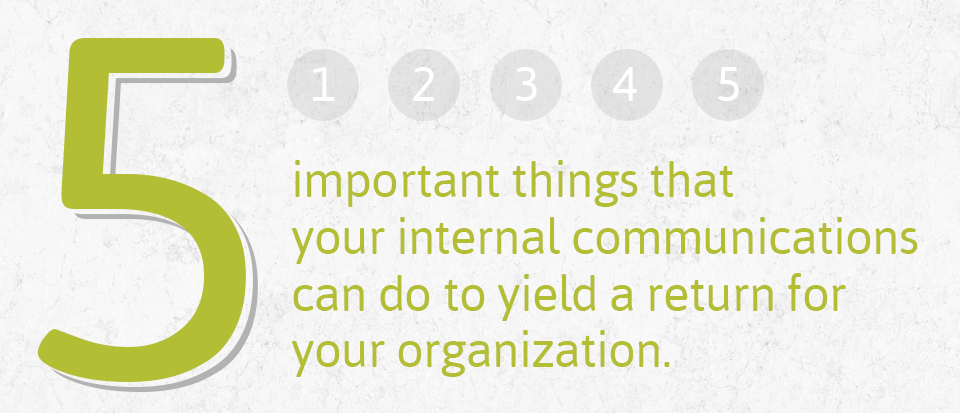Looking for a way to measure the success of your internal communications? Where there’s a will, there’s a way. In this age of tightening budgets, every area of a company’s operations is held up to scrutiny and asked a single question: What return on investment are you providing? There are five important things that your internal communications can do to yield a return for your organization.
#1: Engage Your Workforce. A recent Gallup survey revealed an astounding set of statistics. In the average American workplace, only 29 percent of team members are “actively engaged” – meaning that they enthusiastically seek out additional ways to satisfy customers and help their company succeed. The remaining 71 percent simply do what is required to get by – or less.
How do you make sure that your workforce is engaged? Step one is to maintain high standards for hiring employees and focus on those who embrace opportunity. Secondly, make sure that your internal communications motivate your staff. Clearly communicate the type of performance that propels your company forward– and recognize and reward employees who exemplify that behavior.
#2: Improve Your Business. Communication is a two-way street. Opening a dialog between you and your team can have many direct benefits, including:
- Gather Ideas. Your employees will provide a constant stream of suggestions on how to improve service, productivity, and profitability.
- Spot Problems. Your employees may not always have answers, but it’s a good bet that they’re the first to spot problems. Get them talking about their observations and answers will follow.
- Thwart the “Rumor Mill.” Any organization with more than 10 people usually has a rumor mill. The best way to thwart rumors is simple: communicate.
#3: Drive Performance. An engaged workforce will naturally strive to provide better service and be more productive. But powerful things can happen when you focus them toward a single mission.
- Do you need to reduce absenteeism or lateness? Want to set new benchmarks in response time or problem resolution? Trying to increase the average transaction amount, or achieve a perfect safety record?
- When you give an engaged workforce a clearly defined objective, there is nowhere performance can go but up!
#4: Reduce Costs and Waste. In every organization, employees can make your company stronger by minimizing costs and waste. It may be controlling healthcare costs by requesting generic drugs. It might be as simple as resetting factory thermostats. It may be improving attendance, cutting manufacturing errors – the list goes on.
- Within your company, there are areas for improvement that would generate tangible benefits. Sometimes, getting results doesn’t take a complex plan; it can be as simple as reminding people of something that they already know.
#5: Turn Your Entire Employee Pool into a Sales Department. At Disneyworld, employees are called “cast members” and feel that they are key actors in a major production that takes place every day. At H-E-B Foodstores (an RSW client) they’re called “Partners” and have a sincere sense of ownership. Think of your team members as “brand ambassadors.” Amazing things happen when your employees become so immersed in your mission that they become living, breathing advertisements for your company. For most companies, the sales force consists of maybe 5 percent of their employees. But for truly great companies, that number is 100 percent.
- The benefits we listed here look good on paper. But how do you actually measure them? There are several ways: How many suggestions are you getting from your team? How many emails and favorable letters are coming in from your customers? When you set a clear objective for your team, do you see noticeable headway by the next quarter? Are your employees providing you with new recruits, new ideas, and new opportunities for revenue?
- So make sure to review your past efforts to see if you’ve been getting a full return from your efforts. Or call RSW to see how you can start assigning metrics to the vitally important area of employee communications.





